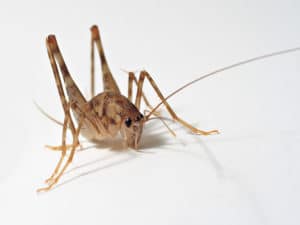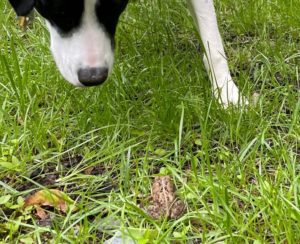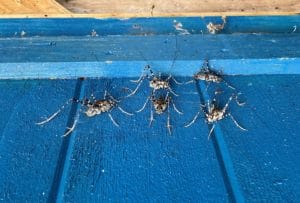Hello fellow readers, Jolee came upon an American toad in the lawn to the left of a drainage swale. I’m glad she didn’t pounce for the kill, the fate of cave crickets, though we are grateful for her finesse. Our rescue pup is indeed earning her keep. The darn things adore the basement, with a few wanderers finding their way upstairs. Bringing a curiosity— do cave crickets benefit the garden?
I didn’t witness firsthand, but Curt managed a few photos of Jolee crouching down in let’s play mode, eyeing the toad.
“How did the greeting end,” I asked?
“I led her away, nervous she would get too rough with it.”
Also called spider crickets, I researched to see if they have an impact or purpose in the garden— as pollinators, perhaps? Not so. However, they provide food for other critters. And contribute to the decaying process, I suppose.
Tips on keeping cave crickets from invading your home:
They hunker down in rotting logs, trees, and compost piles on which they feed. So, keep firewood and compost far from your home. They are also fond of dense ground covers like pachysandra and ivy.
The best defense is to prevent an invasion by keeping plants and mulch a few feet away from the foundation. Seal any gaps they can enter, such as dryer vents, and remove moisture using a dehumidifier.
Our big no-no— don’t store boxes in the basement, especially near the walls, as cave crickets love to eat cardboard. If you must use boxes, keep them on palettes away from the walls. Better yet, buy bins made of recycled plastic.
Habits of Cave Crickets

Photo Attribution: Thegreenj, CC BY-SA 3.0 <http://creativecommons.org/licenses/by-sa/3.0/>, via Wikimedia Commons. Page URL: https://commons.wikimedia.org/wiki/File:Ceuthophiluscricket.jpg
Also called camel crickets or camelback crickets due to their humped back, they don’t chirp like classic crickets. They make no sounds at all, these stealth invaders. About a half-inch to an inch and a half long, their large hind legs equip them to be masterful jumpers feeling the approach of an attacker with their sensitive long antennas that extend well beyond their bodies.
While they aren’t dangerous to humans or pets as they don’t bite or carry disease, they have chewing mouthparts and aren’t fussy about what they feast on. So they eat other insects—not a bad thing—and houseplants, clothing, and linens –maddening!
Be warned about outside fabrics.
Outside they’ll feed on plants, decaying organic matter, even lawn furniture cushions and clothing on your clothesline, so best not to leave them out overnight.
It’s their swift masterful jumping from side to side and backward that made them comical to me— that was before the invasion. Dear Curt was the frontman spraying the nasty spray as the cave crickets by the hundreds jumped all over him. Then, vacating the house for a few hours for the air to clear, we returned to vacuum the carcasses—icky poo. Since then, sticky traps are doing the trick by and large.
Most of the hundred species in the United States and Canada reside east of the Mississippi and are light tan to deep brown. And while some are native, one of the most common is the greenhouse camel cricket (Diestrammena asynamora) from Asia, first found in the US in the 19th century in greenhouses.
Camel crickets date back to prehistoric times.
What appears to be a carving of a female cave cricket from the Troglophilus genus was found on a bison bone in the Cave of the Trois-Frères in the southwest of France, famous for cave art archaeologists believe dates back to 13,000 BC—resilient creatures!
There’s another tidbit since our last week’s chat about the benefits of frogs and toads. Yesterday, while walking the footbridge over the pond, a hawk was feeding then quickly flew from Jolee’s curiosities. Remnants of a bullfrog were left behind, a sad fate. We enjoyed the chubby fellow who always sat along the pond’s edge, blending into the green algae.
“It’s the cycle of life,” Curt said. And while it is, it makes for a heavy heart. Though clearly, there are inconsistencies in my sentiments for cave crickets.
Garden Dilemmas? AskMaryStone.@gmail.com (and your favorite Podcast App.)
Click through to the story of Attracting Toads to your Garden
I share the story of Ken’s “voluptuous” cave crickets and his magical song titled Mandrakes, another name for mayapple, in Ep. 31 of the Garden Dilemmas Podcast- link below.
To learn more about cave cricket, including a hefty list of subfamilies and genera worldwide, check out Wikipedia’s article on Rhaphidophoridae.





